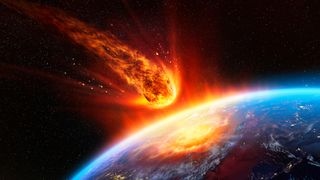Asteroids of this size are big enough to cause mass extinction events.

A “planet killer” asteroid that is hiding in the glare of the sun has finally been detected, and the giant space rock could smash into Earth one day.
The 0.9-mile-wide (1.5 kilometers) “potentially hazardous” asteroid, named 2022 AP7, is one of several large space rocks that astronomers recently discovered near the orbits of Earth and Venus.
Currently, 2022 AP7 crosses Earth’s orbit while our planet is on the opposite side of the sun, but scientists say that over thousands of years, the asteroid and Earth will slowly start to cross the same point closer together, thereby increasing the odds of a catastrophic impact. The asteroid, discovered alongside two other near-Earth asteroids using the Cerro Tololo Inter-American Observatory in Chile, was described in a study published Sept. 29 in The Astronomical Journal.
“So far we have found two large near-Earth asteroids [NEAs] that are about 1 km [0.6 mile] across, a size that we call planet killers,” lead study author Scott Sheppard, an astronomer at the Carnegie Institution for Science in Washington, D.C., said in a statement.
“Planet killer” asteroids are space rocks that are big enough to cause a global mass extinction event, through the chucking up of dust into the upper atmosphere and the blotting out of the sun’s light, if they were to smash into Earth.
To find the asteroids, the astronomers trained the Cerro Tololo Víctor M. Blanco 4-meter Telescope’s Dark Energy Camera on the inner solar system. The sun’s glare makes observations impossible for most of the day, so the researchers had just two 10-minute windows of twilight each night to make their observations.
“Only about 25 asteroids with orbits completely within Earth’s orbit have been discovered to date because of the difficulty of observing near the glare of the Sun,” Sheppard said. “There are likely only a few NEAs with similar sizes left to find, and these large undiscovered asteroids likely have orbits that keep them interior to the orbits of Earth and Venus most of the time.”
NASA tracks the locations and orbits of roughly 28,000 asteroids, following them with the Asteroid Terrestrial-impact Last Alert System (ATLAS), an array of four telescopes that can perform a scan of the entire night sky every 24 hours. The space agency flags any space object that comes within 120 million miles (193 million km) of Earth as a “near-Earth object” and classifies any large body within 4.65 million miles (7.5 million km) of our planet as “potentially hazardous.”
Since ATLAS was brought online in 2017, it has spotted more than 700 near-Earth asteroids and 66 comets. Two of the asteroids detected by ATLAS, 2019 MO and 2018 LA, actually hit Earth, the former exploding off the southern coast of Puerto Rico and the latter crash-landing near the border of Botswana and South Africa. Fortunately, those asteroids were small and didn’t cause any damage.
NASA has estimated the trajectories of all the near-Earth objects beyond the end of the century. Earth faces no known danger from an apocalyptic asteroid collision for at least the next 100 years, according to NASA. But this doesn’t mean astronomers think they should stop looking. In March 2021, for example, a bowling ball-size meteor exploded over Vermont with the force of 440 pounds (200 kilograms) of TNT. Even more dramatically, a 2013 explosion of a meteor above Chelyabinsk, Russia, generated a blast roughly equal to around 400 to 500 kilotons of TNT, or 26 to 33 times the energy released by the Hiroshima bomb, and injured around 1,500 people.
Space agencies around the world are already working on possible ways to deflect a dangerous asteroid if one were ever headed our way. On Sept. 26, the Double Asteroid Redirection Test (DART) spacecraft redirected the nonhazardous asteroid Dimorphos by ramming it off course, altering the asteroid’s orbit by 32 minutes in the first test of Earth’s planetary defense system.
China has also suggested it is in the early planning stages of an asteroid-redirect mission. By slamming 23 Long March 5 rockets into the asteroid Bennu, which will swing within 4.6 million miles (7.4 million km) of Earth’s orbit between the years 2175 and 2199, the country hopes to divert the space rock from a potentially catastrophic impact with our planet.







